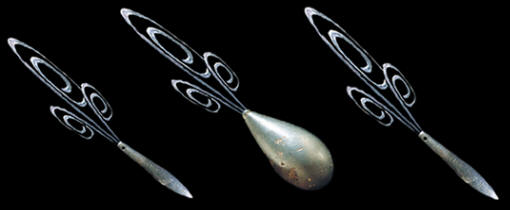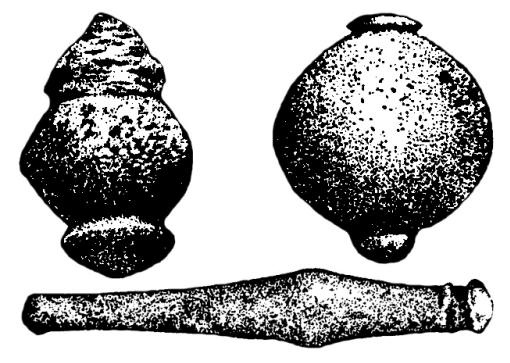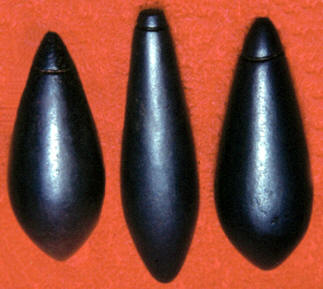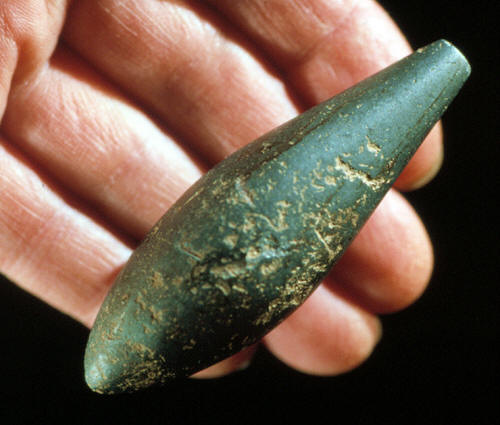|
|
|
Plummets have been found in caches. Sometime in the 1890's a farmer in Calhoun County, Illinois found a cache of 28 Godar plummets. Finding plummets in caches supports the theory that multiple examples were used as weights on nets. But Perino writes that, "The history of plummets, when found associated with burials, consists of from one to five specimens, indicating that they may have been used as individual just as well as group equipment." He also writes that, "The presence of plummets as well as their position, when with human remains, reveals little or nothing regarding their possible usage." The Klunk Mound 7 excavation in southern Illinois contained burials with single plummets. One was found next to a femur in one burial and in another, one had been placed under a skull. All the plummets found with burials in Klunk Mound 7, when it could be determined, were found with male remains. |
|
|
|
|
One of the most confusing issues concerning plummets is their area of attachment. Moorehead writes, "----the grooves on most of the hematite plummets are too narrow and shallow for the attachment of any save the most slender cords." If plummets were all drilled at the base like Godar plummets and the earliest California types, it would be easier to assume they could have been directly and securely attached to nets. But most plummets are only grooved and some have only very delicate grooves right at the end. Many examples have what can be described as only an engraved line to represent the groove and some are not grooved at all. So it would seem that these plummets wouldn't have had enough structural integrity for a secure attachment, especially if they were to receive heavy use as net weights. Apparently, the only alternative would have been to encase the plummet in a pouch or bag made of animal skin. It would be more logical to believe that these weak and delicate attachment locations would have more likely held a small object, like an attached feather. However, some of the later period undrilled spindle-shaped plummets found in California have been found with asphaltum and cord impressions on the neck. Proving they were suspended even though they might appear not to have had a strong hafting area. The asphaltum seep in Marin County, California was exploited by groups in the area for the natural adhesive it provided. |
|
|
|
|
Many plummets can be placed in a class all their own, in reference to superior craftsmanship. Which means they may be extra large, made into one of the highly stylized forms, have highly polished surfaces, fine engraving, made from a particularly nice material, etc. So it seems illogical to assume that all plummets would have been used for a utilitarian purpose. They may also have been used either as fetishes, charms, talismans, amulets, lucky-stones or medicine-stones. The Poverty Point plummet illustrated in this article is a good example. It's so highly developed in design and surface finish that it's logical to assume that it was used as a ritual item rather than for a utilitarian purpose. An example of this way of thinking, as written by Holmes, illustrates some of these spiritual concepts, "It is worthy of note that the aborigines generally are disposed to attribute magical significance to all old worked stones----" He refers to the Chippewa in regard to their ideas about old plummets they had collected. "The ancient name of the plummet type was majabawasin, a stone (-asin) of human attributes (-aba-) that casts a spell (moj-). He goes on to say, "It's present name is shingabawasin, stone of human attributes lying at rest." Many examples of very finely crafted plummets have been found along the Pacific coast and in states east of the Mississippi River. It's logical to assume that many of them must have been used as ritual items. |
|
|
|
|
It would be interesting to know where the idea for the tear-drop shape, as it relates to ancient plummets, originated. Why wouldn't they have been made into any one of a multitude of other shapes, like small rectangles, or in the shape of some type of animal. If there was a mythological concept connected with the tear-drop shape, it was powerful enough to sustain itself for thousands of years over an area covering thousands of miles. As suggested by an avid duck hunter, Jim Marlin, the tear-drop shape can be seen in water fowl in the form of long necks and round bodies and that image would fit well with objects used to hunt ducks with nets. Another source for the basic tear-drop plummet design may have originated from sightings of bolides or meteors flying across the sky. This would be the most powerful source in nature for a tear-drop shape. The author has met three people who have witnessed two separate meteors that fell so close nearby that they were collected either by them or a neighbor. They were both daylight events and they were impressive for the sound, light and smoke they made. In one case the meteor hit and broke a tree limb. In the other, it hit an open field. These natural events must have been impressive to ancient cultures. One way a person might have recorded a meteoric event would have been to make a tear-drop shaped object out of a heavy material, such as hematite. The author also witnessed a meteor or bolide several years ago that was large and traveled horizontally low in the northern sky. It was red in the thick atmosphere, like the color of some hematite plummets, and in the shape of a tear-drop. |
|
|
"REFERENCES"
1896, Fowke, Gerard, "Stone Art, (Plummets)" Thirteenth Annual
Report of the Bureau of Ethnology, pp. 110-114. |
|



